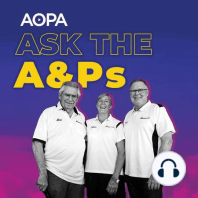55 min listen
"This is a classic infant mortality failure"
FromAsk the A&Ps
ratings:
Length:
72 minutes
Released:
Apr 1, 2023
Format:
Podcast episode
Description
With two important airworthiness directives recently issued for Continental engines and Cessna Cardinals and 210s, Mike, Paul, and Colleen dig deep on the surrounding capacity and safety issues. Then they take calls on the limitations of engine monitors, and how normal can look anything but. Submit your questions to podcasts@aopa.org for a chance to get on the show.
Full notes below:
Michael has a turbonormalized Bonanza and he’s concerned his system isn’t operating properly. When full throttle on takeoff it overboosts, so he goes to partial throttle, which lowers the fuel flow. The controller and waste gate were both checked with no change. Mike says it’s a very bad idea to limit the manifold pressure with throttle. Continental says overboosting by 3 inches is a non-event. What is a big event is limiting fuel flow. The fuel flow is determined by the upper deck pressure, which could be adjusted. Either way, Mike says that Michael can leave it alone and give it all the beans.
Paul is shopping for an engine monitor and is wondering if the hosts have any advice. Of course they do! Mike recommends user-programmable alerts. Otherwise they recommend you buy the one that best fits in your panel. A slew of recommendations on how to use it follow.
Laurie’s engine runs roughly in a certain rpm range unless she leans to peak EGT. The hosts soon learn that she operates from an airport at more than 7,000 feet. Mike thinks it’s likely this is normal behavior because the engine runs too rich at full power at such a high elevation.
John thinks he might be experiencing morning sickness on his RV-7’s O-360 engine. He is noticing an increase of lead buildup each time he borescopes it. The CHTs are also too low, at around 300 degrees in the winter. He felt the engine was running rough for a few minutes after starting, as well. The hosts look at John’s photos and think his engine is perfect. Paul mentions that so long as the valve seats well, the gunk in the cylinder is fine. They offer a number of ideas on increasing his CHTs.
Steve is frustrated with his engine monitor because he's experiencing what he believes are nuisance alarms. The issue is that his engine manual and POH have different numbers, and the engine monitor is programmed with the POH numbers. The engine monitor can be reprogrammed, but it’s expensive and requires input from a mechanic. This is mostly an issue with engine monitors that are certificated for primary replacement.
Full notes below:
Michael has a turbonormalized Bonanza and he’s concerned his system isn’t operating properly. When full throttle on takeoff it overboosts, so he goes to partial throttle, which lowers the fuel flow. The controller and waste gate were both checked with no change. Mike says it’s a very bad idea to limit the manifold pressure with throttle. Continental says overboosting by 3 inches is a non-event. What is a big event is limiting fuel flow. The fuel flow is determined by the upper deck pressure, which could be adjusted. Either way, Mike says that Michael can leave it alone and give it all the beans.
Paul is shopping for an engine monitor and is wondering if the hosts have any advice. Of course they do! Mike recommends user-programmable alerts. Otherwise they recommend you buy the one that best fits in your panel. A slew of recommendations on how to use it follow.
Laurie’s engine runs roughly in a certain rpm range unless she leans to peak EGT. The hosts soon learn that she operates from an airport at more than 7,000 feet. Mike thinks it’s likely this is normal behavior because the engine runs too rich at full power at such a high elevation.
John thinks he might be experiencing morning sickness on his RV-7’s O-360 engine. He is noticing an increase of lead buildup each time he borescopes it. The CHTs are also too low, at around 300 degrees in the winter. He felt the engine was running rough for a few minutes after starting, as well. The hosts look at John’s photos and think his engine is perfect. Paul mentions that so long as the valve seats well, the gunk in the cylinder is fine. They offer a number of ideas on increasing his CHTs.
Steve is frustrated with his engine monitor because he's experiencing what he believes are nuisance alarms. The issue is that his engine manual and POH have different numbers, and the engine monitor is programmed with the POH numbers. The engine monitor can be reprogrammed, but it’s expensive and requires input from a mechanic. This is mostly an issue with engine monitors that are certificated for primary replacement.
Released:
Apr 1, 2023
Format:
Podcast episode
Titles in the series (56)
'You're not going to fall out of the sky because the camshaft wears': Snake oil, cranky turbochargers, oil issues, camshaft rust, and more in this month's episode. Plus, a new owner tries to stump Mike, Paul, and Colleen on propeller rpm checks. by Ask the A&Ps
